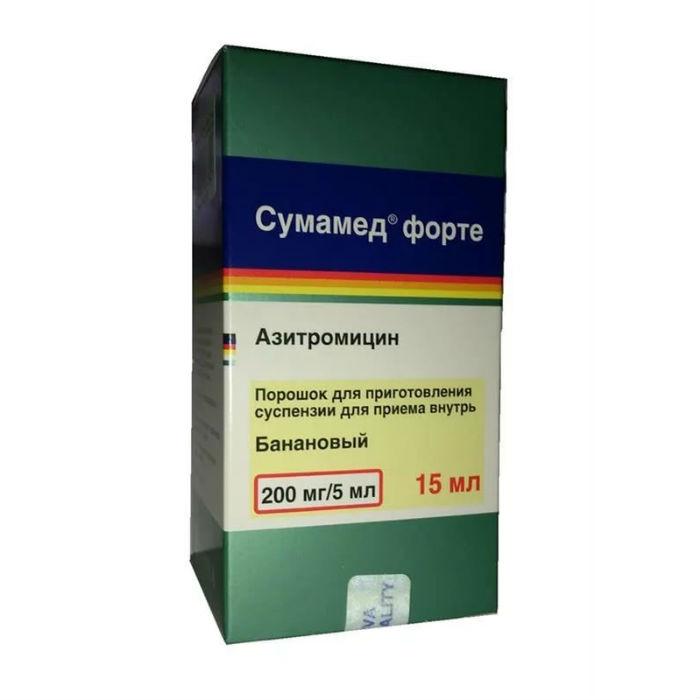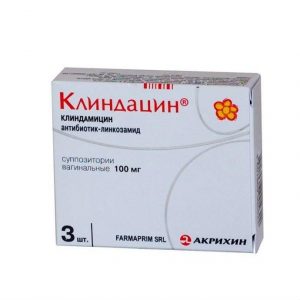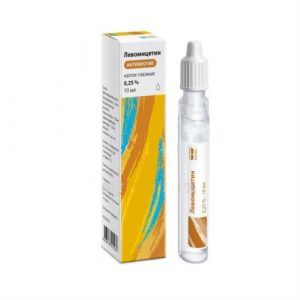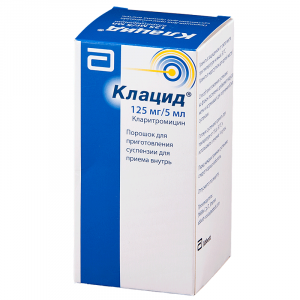Description
Latin name
Sumamed forte
Release form
Powder for preparing an oral suspension
A
package of 16.740 g or 29.295 g of powder is placed in a brown glass bottle with a volume of 50 ml or 100 ml with a polypropylene resistant cap. 1 bottle with instructions for use, a two-sided measuring spoon and / or a syringe for dispensing are placed in a cardboard bundle.
Pharmacological action
Sumamed forte – macrolide antibiotic group – azalide. It has a wide range of antimicrobial effects. It binds to the 50S subunit of the ribosome, inhibits the biosynthesis of protein microorganisms. In high concentrations it has a bactericidal effect.
Azithromycin is active against gram-positive aerobic bacteria: Streptococcus pneumoniae, Streptococcus pyogenes, Streptococcus agalactiae, Streptococcus viridans, streptococcus groups C, F and G, Staphylococcus aureus, Staphylococcus epidermidis of some gram-positive anaerobic bacteria: Clostridium perfringens.
Azithromycin is active against gram-negative aerobic bacteria: Haemophilus influenzae, Haemophilus parainfluenzae, Haemophilus ducreyi, Moraxella catarrhalis, Bordetella pertussis, Bordetella parapertisseris, Berlissa mellis infection, Neisseria gonorrrhoeae, Jerisseri malaria
Azithromycin is also active against intracellular and other microorganisms: Mycobacterium avium complex, Legionella pneumophila, Chlamydia trachomatis, Chlamydia pneumoniae, Mycoplasma pneumoniae, Ureaplasma urealyticum, Listeria monocitogenes, Borrelia burgerferma burgfer.
Gram-positive bacteria resistant to erythromycin are resistant to the drug.
Indications
Infectious and inflammatory diseases caused by microorganisms sensitive to the drug: – infections of the upper respiratory tract and ear (bacterial pharyngitis, tonsillitis, sinusitis, otitis media)
– infections of the lower respiratory tract (bacterial bronchitis, interstitial and bronchitis exacerbation of chronic bronchitis)
– infections of the skin and soft tissues (chronic migratory erythema – the initial stage, Lyme disease, erysipelas, impetigo, secondary dermatoses)
– infections, p redavaemye sexually (urethritis, cervicitis)
– diseases of stomach and duodenal ulcers associated with Helicobacter pylori.
Contraindications
– severe hepatic and renal impairment
– hypersensitivity to the
macrolide group antibiotics Precautions: during pregnancy and lactation, with impaired liver and kidney function, in patients with impaired or predisposed arrhythmias and QT prolongation.
Use during pregnancy and lactation
During pregnancy, the drug should be administered only if the expected benefit to the mother outweighs the potential risk to the fetus. If it is necessary to administer Sumamed to women during lactation, it is necessary to decide on the termination of breastfeeding.
Composition
5 ml of the prepared suspension contain azithromycin dihydrate 200 mg
auxiliary components: sucrose, trisodium phosphate anhydrous, hydroxypropyl cellulose, xanthan gum, cherry flavor J7549, banana 78701-31, silicon vanilla D-125038, silicon dioxide.
Side effects
Rarely (in 1% of cases or less).
From the digestive system: melena, cholestatic jaundice, nausea, vomiting, diarrhea, constipation, decreased appetite, gastritis, a reversible moderate increase in the activity of liver enzymes.
From the urinary system: jade.
From the reproductive system: vaginal candidiasis.
From the cardiovascular system: palpitations, chest pain.
From the side of the central nervous system and peripheral nervous system: dizziness, headache, vertigo, drowsiness, increased fatigue in children – headache (with treatment of otitis media), hyperkinesia, anxiety, neurosis, sleep disturbances.
Allergic reactions: skin rashes, Quincke’s edema, urticaria, conjunctivitis.
Dermatological reactions: photosensitivity, pruritus.
On the part of laboratory parameters: in some cases – neutrophilia, eosinophilia (changed indicators return to normal 2-3 weeks after discontinuation of treatment).
Drug Interactions
Antacids (containing aluminum, magnesium), ethanol and food greatly reduce the absorption of azithromycin (capsules and suspension), so the drug should be taken at least 1 hour before or after 2 hours drugs and food.
Azithromycin, unlike other macrolide antibiotics, does not bind to isoenzymes of the cytochrome P450 system. No interactions with theophylline, terfenadine, carbamazepine, triazolam, digoxin have been reported to date.
Macrolides when co-administered with cycloserine, indirect anticoagulants, methylprednisolone, felodipine, and drugs subject to microsomal oxidation (cyclosporine, hexobarbital, ergot alkaloids, valproic acid, disopyramide, bromocriptine, phenytoin, oral hypoglycemic agents), delay the excretion, increase the concentration and toxicity of these drugs, while no such interaction has been reported so far with the use of azalides.
Careful monitoring of prothrombin time is recommended when co-administered with warfarin.
The simultaneous administration of macrolides with ergotamine and dihydroergotamine may result in their toxic effect (vascular spasm, dysesthesia).
Linkosamines decrease and tetracycline and chloramphenicol increase the effectiveness of azithromycin.
Pharmaceutically azithromycin incompatible with heparin.
Overdose
Symptoms: nausea, vomiting, diarrhea, temporary hearing loss.
Treatment: symptomatic.
Storage conditions
Keep out of the reach of children at temperatures from 15 ° to 25 ° C.
Expiration
2 years.
The Expiration of the prepared suspension is 5 days.
Deystvuyuschee substances
Azithromycin
Pharmacy terms 17 Pharmaceuticals 17 Pharmaceuticals177 Product code 5176ffafaf17 Pharmaceuticals Pharmaceutical products Pharmaceutical products from
pharmacies Prescription
Dosage form a suspension for oral
Pliva Hrvatska doo, Croatia




